Nursing Research: A Comprehensive Appraisal of Music Therapy Study
VerifiedAdded on 2023/06/10
|9
|1768
|256
Report
AI Summary
This nursing research article appraisal critically evaluates a study by Gallagher et al. (2018) on the impact of music therapy on hospitalized patients post-elective orthopaedic surgery. The appraisal addresses various aspects of the research design, including the sampling method, sample size, inclusion and exclusion criteria, refusal and attrition rates, and ethical considerations. It also examines the instruments used in the study, such as the iPad, REDCap database, point numeric rating scale, and Rogers Happy/Sad Faces Assessment Tool, while also noting limitations in reporting their validity and reliability. Furthermore, the appraisal analyzes the statistical tests used, key findings, and limitations of the study, ultimately assessing the strength and weaknesses of the research and its implications for nursing practice. The report concludes by highlighting the potential for music therapy to address patient discomfort and suggests future research directions to improve the efficacy of the intervention, all while providing a comprehensive overview of the study's methodology and results.
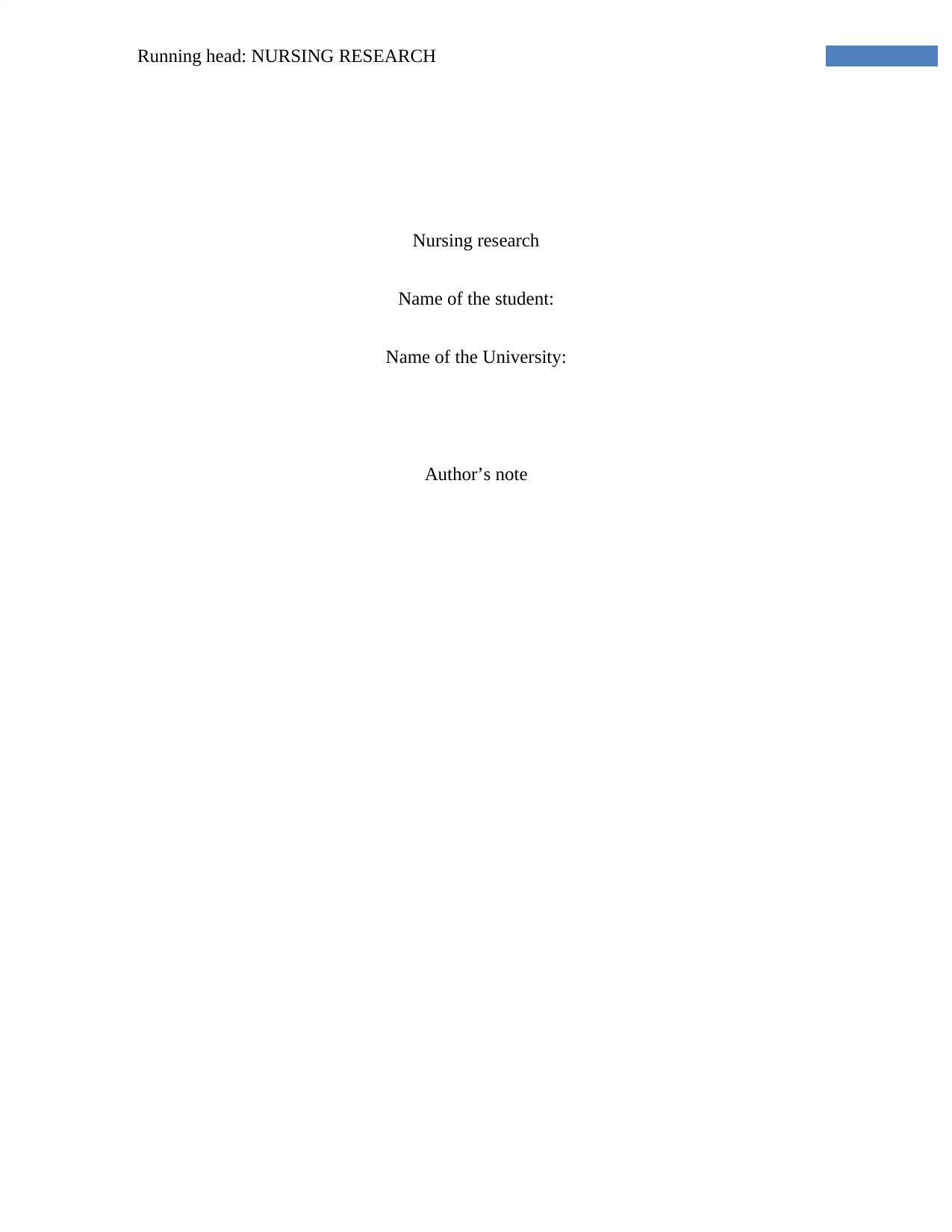
Running head: NURSING RESEARCH
Nursing research
Name of the student:
Name of the University:
Author’s note
Nursing research
Name of the student:
Name of the University:
Author’s note
Paraphrase This Document
Need a fresh take? Get an instant paraphrase of this document with our AI Paraphraser
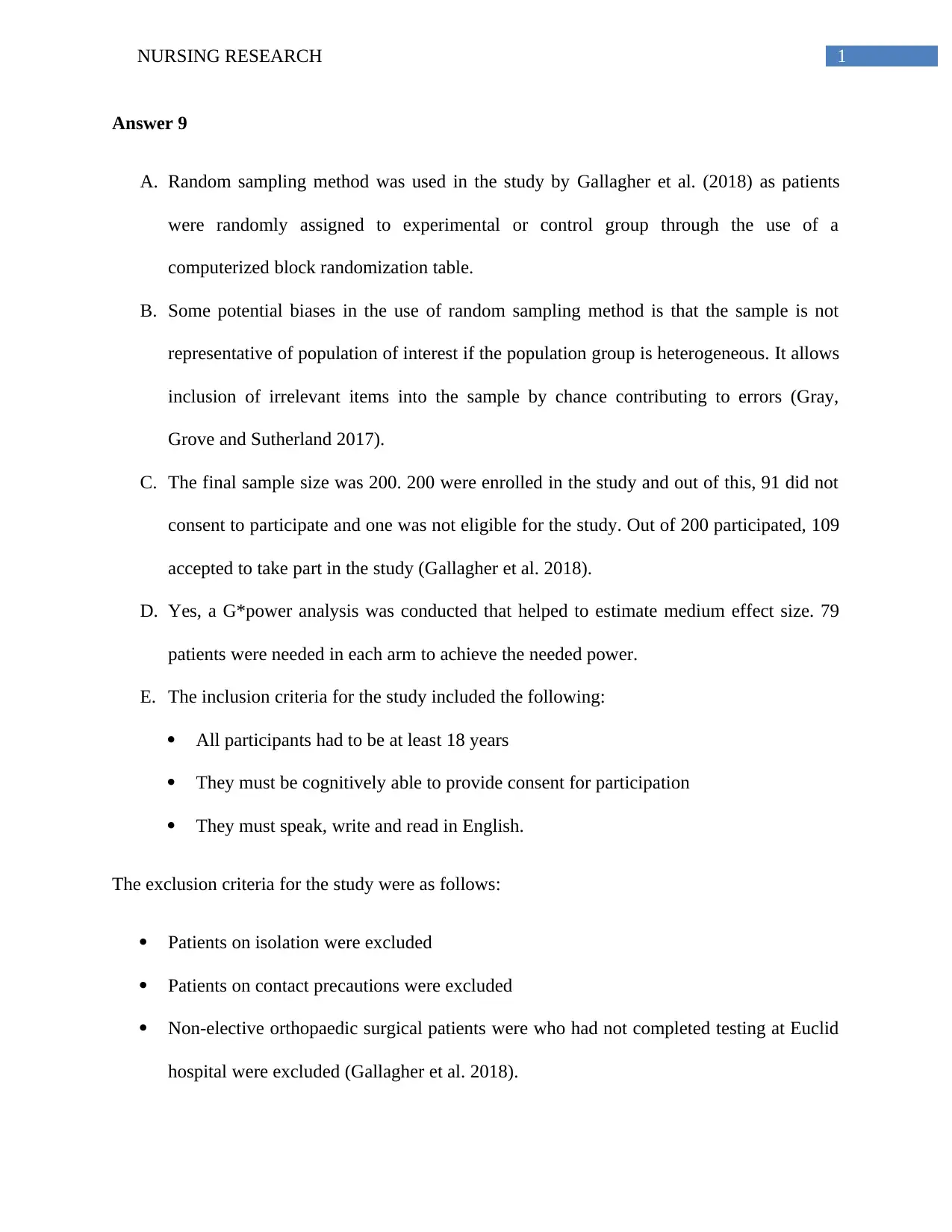
1NURSING RESEARCH
Answer 9
A. Random sampling method was used in the study by Gallagher et al. (2018) as patients
were randomly assigned to experimental or control group through the use of a
computerized block randomization table.
B. Some potential biases in the use of random sampling method is that the sample is not
representative of population of interest if the population group is heterogeneous. It allows
inclusion of irrelevant items into the sample by chance contributing to errors (Gray,
Grove and Sutherland 2017).
C. The final sample size was 200. 200 were enrolled in the study and out of this, 91 did not
consent to participate and one was not eligible for the study. Out of 200 participated, 109
accepted to take part in the study (Gallagher et al. 2018).
D. Yes, a G*power analysis was conducted that helped to estimate medium effect size. 79
patients were needed in each arm to achieve the needed power.
E. The inclusion criteria for the study included the following:
All participants had to be at least 18 years
They must be cognitively able to provide consent for participation
They must speak, write and read in English.
The exclusion criteria for the study were as follows:
Patients on isolation were excluded
Patients on contact precautions were excluded
Non-elective orthopaedic surgical patients were who had not completed testing at Euclid
hospital were excluded (Gallagher et al. 2018).
Answer 9
A. Random sampling method was used in the study by Gallagher et al. (2018) as patients
were randomly assigned to experimental or control group through the use of a
computerized block randomization table.
B. Some potential biases in the use of random sampling method is that the sample is not
representative of population of interest if the population group is heterogeneous. It allows
inclusion of irrelevant items into the sample by chance contributing to errors (Gray,
Grove and Sutherland 2017).
C. The final sample size was 200. 200 were enrolled in the study and out of this, 91 did not
consent to participate and one was not eligible for the study. Out of 200 participated, 109
accepted to take part in the study (Gallagher et al. 2018).
D. Yes, a G*power analysis was conducted that helped to estimate medium effect size. 79
patients were needed in each arm to achieve the needed power.
E. The inclusion criteria for the study included the following:
All participants had to be at least 18 years
They must be cognitively able to provide consent for participation
They must speak, write and read in English.
The exclusion criteria for the study were as follows:
Patients on isolation were excluded
Patients on contact precautions were excluded
Non-elective orthopaedic surgical patients were who had not completed testing at Euclid
hospital were excluded (Gallagher et al. 2018).
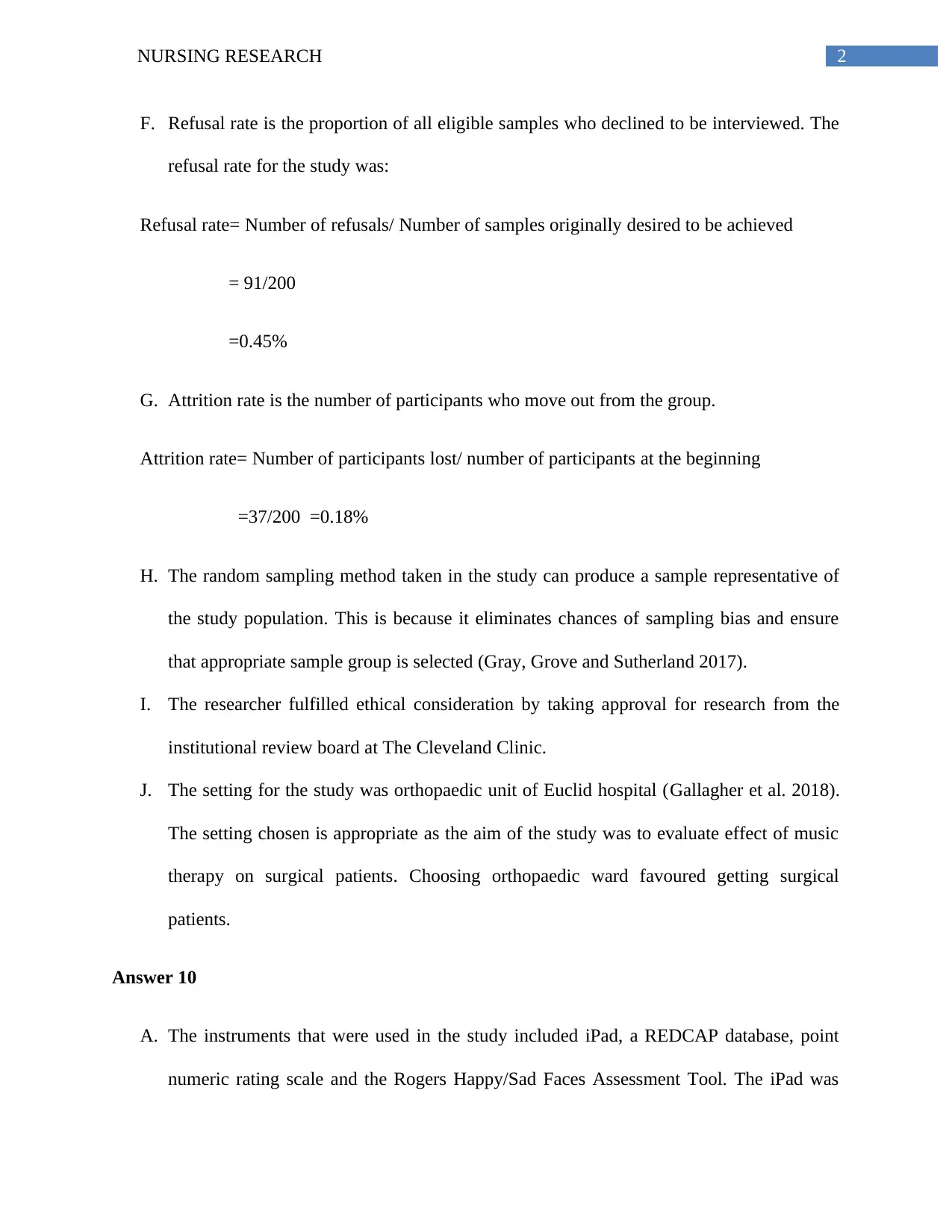
2NURSING RESEARCH
F. Refusal rate is the proportion of all eligible samples who declined to be interviewed. The
refusal rate for the study was:
Refusal rate= Number of refusals/ Number of samples originally desired to be achieved
= 91/200
=0.45%
G. Attrition rate is the number of participants who move out from the group.
Attrition rate= Number of participants lost/ number of participants at the beginning
=37/200 =0.18%
H. The random sampling method taken in the study can produce a sample representative of
the study population. This is because it eliminates chances of sampling bias and ensure
that appropriate sample group is selected (Gray, Grove and Sutherland 2017).
I. The researcher fulfilled ethical consideration by taking approval for research from the
institutional review board at The Cleveland Clinic.
J. The setting for the study was orthopaedic unit of Euclid hospital (Gallagher et al. 2018).
The setting chosen is appropriate as the aim of the study was to evaluate effect of music
therapy on surgical patients. Choosing orthopaedic ward favoured getting surgical
patients.
Answer 10
A. The instruments that were used in the study included iPad, a REDCAP database, point
numeric rating scale and the Rogers Happy/Sad Faces Assessment Tool. The iPad was
F. Refusal rate is the proportion of all eligible samples who declined to be interviewed. The
refusal rate for the study was:
Refusal rate= Number of refusals/ Number of samples originally desired to be achieved
= 91/200
=0.45%
G. Attrition rate is the number of participants who move out from the group.
Attrition rate= Number of participants lost/ number of participants at the beginning
=37/200 =0.18%
H. The random sampling method taken in the study can produce a sample representative of
the study population. This is because it eliminates chances of sampling bias and ensure
that appropriate sample group is selected (Gray, Grove and Sutherland 2017).
I. The researcher fulfilled ethical consideration by taking approval for research from the
institutional review board at The Cleveland Clinic.
J. The setting for the study was orthopaedic unit of Euclid hospital (Gallagher et al. 2018).
The setting chosen is appropriate as the aim of the study was to evaluate effect of music
therapy on surgical patients. Choosing orthopaedic ward favoured getting surgical
patients.
Answer 10
A. The instruments that were used in the study included iPad, a REDCAP database, point
numeric rating scale and the Rogers Happy/Sad Faces Assessment Tool. The iPad was
⊘ This is a preview!⊘
Do you want full access?
Subscribe today to unlock all pages.

Trusted by 1+ million students worldwide
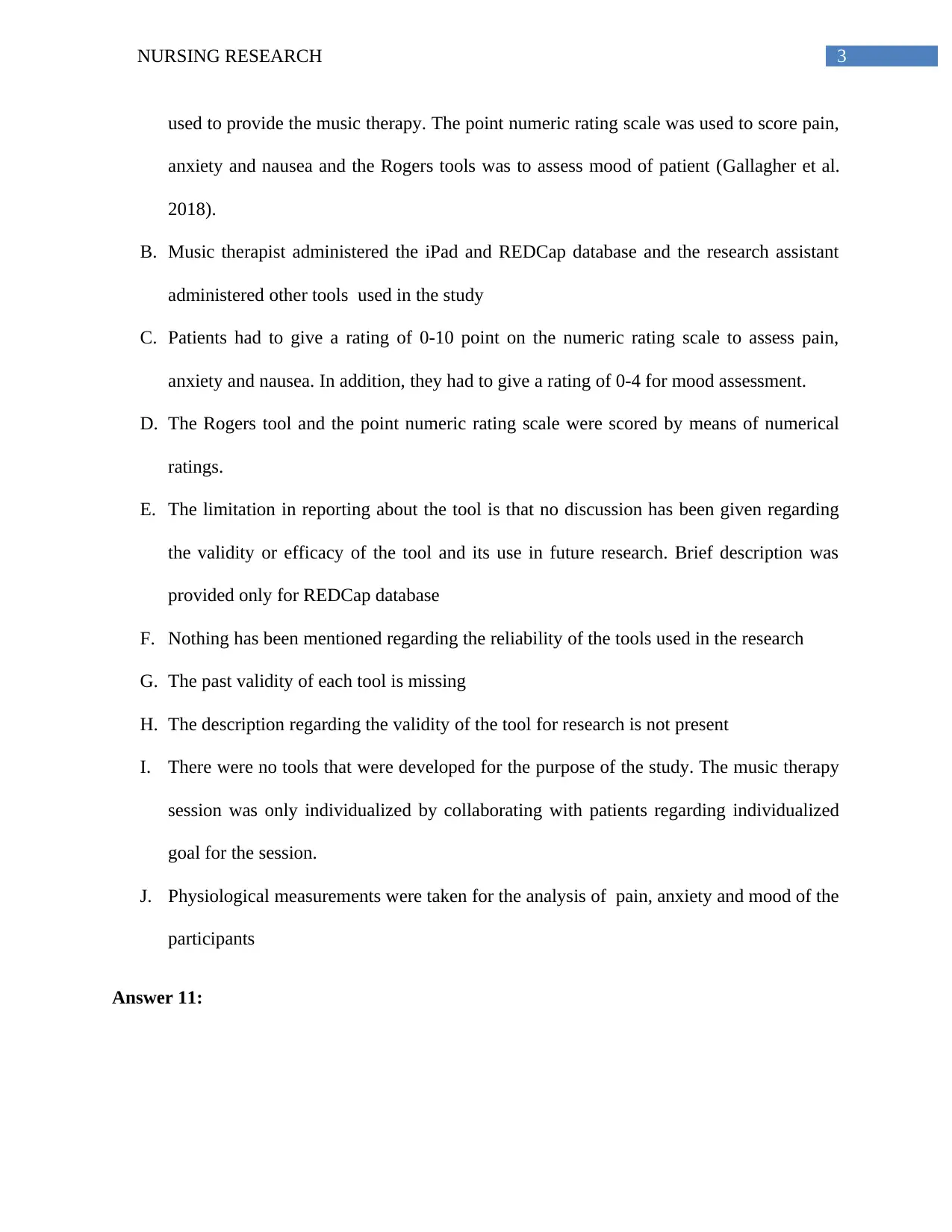
3NURSING RESEARCH
used to provide the music therapy. The point numeric rating scale was used to score pain,
anxiety and nausea and the Rogers tools was to assess mood of patient (Gallagher et al.
2018).
B. Music therapist administered the iPad and REDCap database and the research assistant
administered other tools used in the study
C. Patients had to give a rating of 0-10 point on the numeric rating scale to assess pain,
anxiety and nausea. In addition, they had to give a rating of 0-4 for mood assessment.
D. The Rogers tool and the point numeric rating scale were scored by means of numerical
ratings.
E. The limitation in reporting about the tool is that no discussion has been given regarding
the validity or efficacy of the tool and its use in future research. Brief description was
provided only for REDCap database
F. Nothing has been mentioned regarding the reliability of the tools used in the research
G. The past validity of each tool is missing
H. The description regarding the validity of the tool for research is not present
I. There were no tools that were developed for the purpose of the study. The music therapy
session was only individualized by collaborating with patients regarding individualized
goal for the session.
J. Physiological measurements were taken for the analysis of pain, anxiety and mood of the
participants
Answer 11:
used to provide the music therapy. The point numeric rating scale was used to score pain,
anxiety and nausea and the Rogers tools was to assess mood of patient (Gallagher et al.
2018).
B. Music therapist administered the iPad and REDCap database and the research assistant
administered other tools used in the study
C. Patients had to give a rating of 0-10 point on the numeric rating scale to assess pain,
anxiety and nausea. In addition, they had to give a rating of 0-4 for mood assessment.
D. The Rogers tool and the point numeric rating scale were scored by means of numerical
ratings.
E. The limitation in reporting about the tool is that no discussion has been given regarding
the validity or efficacy of the tool and its use in future research. Brief description was
provided only for REDCap database
F. Nothing has been mentioned regarding the reliability of the tools used in the research
G. The past validity of each tool is missing
H. The description regarding the validity of the tool for research is not present
I. There were no tools that were developed for the purpose of the study. The music therapy
session was only individualized by collaborating with patients regarding individualized
goal for the session.
J. Physiological measurements were taken for the analysis of pain, anxiety and mood of the
participants
Answer 11:
Paraphrase This Document
Need a fresh take? Get an instant paraphrase of this document with our AI Paraphraser
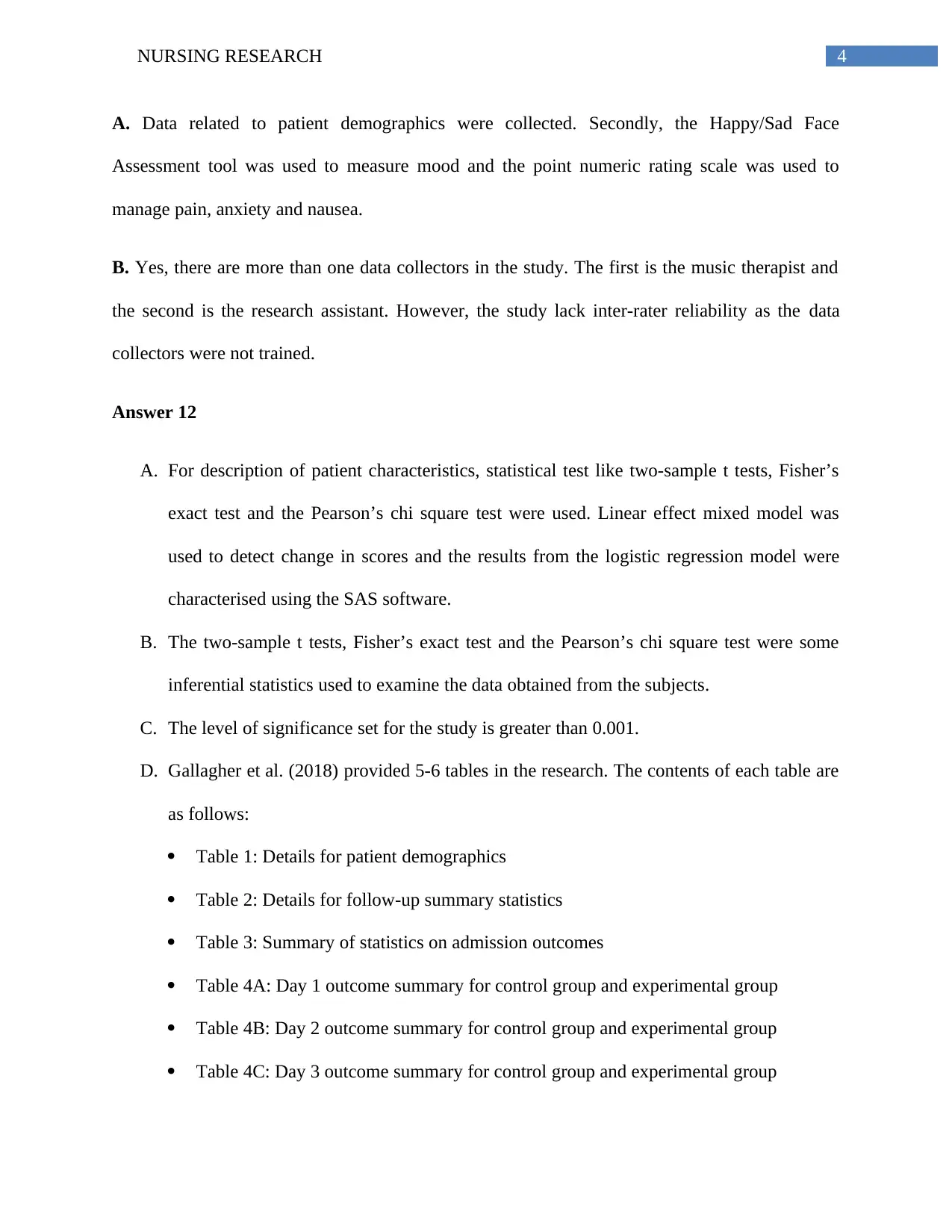
4NURSING RESEARCH
A. Data related to patient demographics were collected. Secondly, the Happy/Sad Face
Assessment tool was used to measure mood and the point numeric rating scale was used to
manage pain, anxiety and nausea.
B. Yes, there are more than one data collectors in the study. The first is the music therapist and
the second is the research assistant. However, the study lack inter-rater reliability as the data
collectors were not trained.
Answer 12
A. For description of patient characteristics, statistical test like two-sample t tests, Fisher’s
exact test and the Pearson’s chi square test were used. Linear effect mixed model was
used to detect change in scores and the results from the logistic regression model were
characterised using the SAS software.
B. The two-sample t tests, Fisher’s exact test and the Pearson’s chi square test were some
inferential statistics used to examine the data obtained from the subjects.
C. The level of significance set for the study is greater than 0.001.
D. Gallagher et al. (2018) provided 5-6 tables in the research. The contents of each table are
as follows:
Table 1: Details for patient demographics
Table 2: Details for follow-up summary statistics
Table 3: Summary of statistics on admission outcomes
Table 4A: Day 1 outcome summary for control group and experimental group
Table 4B: Day 2 outcome summary for control group and experimental group
Table 4C: Day 3 outcome summary for control group and experimental group
A. Data related to patient demographics were collected. Secondly, the Happy/Sad Face
Assessment tool was used to measure mood and the point numeric rating scale was used to
manage pain, anxiety and nausea.
B. Yes, there are more than one data collectors in the study. The first is the music therapist and
the second is the research assistant. However, the study lack inter-rater reliability as the data
collectors were not trained.
Answer 12
A. For description of patient characteristics, statistical test like two-sample t tests, Fisher’s
exact test and the Pearson’s chi square test were used. Linear effect mixed model was
used to detect change in scores and the results from the logistic regression model were
characterised using the SAS software.
B. The two-sample t tests, Fisher’s exact test and the Pearson’s chi square test were some
inferential statistics used to examine the data obtained from the subjects.
C. The level of significance set for the study is greater than 0.001.
D. Gallagher et al. (2018) provided 5-6 tables in the research. The contents of each table are
as follows:
Table 1: Details for patient demographics
Table 2: Details for follow-up summary statistics
Table 3: Summary of statistics on admission outcomes
Table 4A: Day 1 outcome summary for control group and experimental group
Table 4B: Day 2 outcome summary for control group and experimental group
Table 4C: Day 3 outcome summary for control group and experimental group
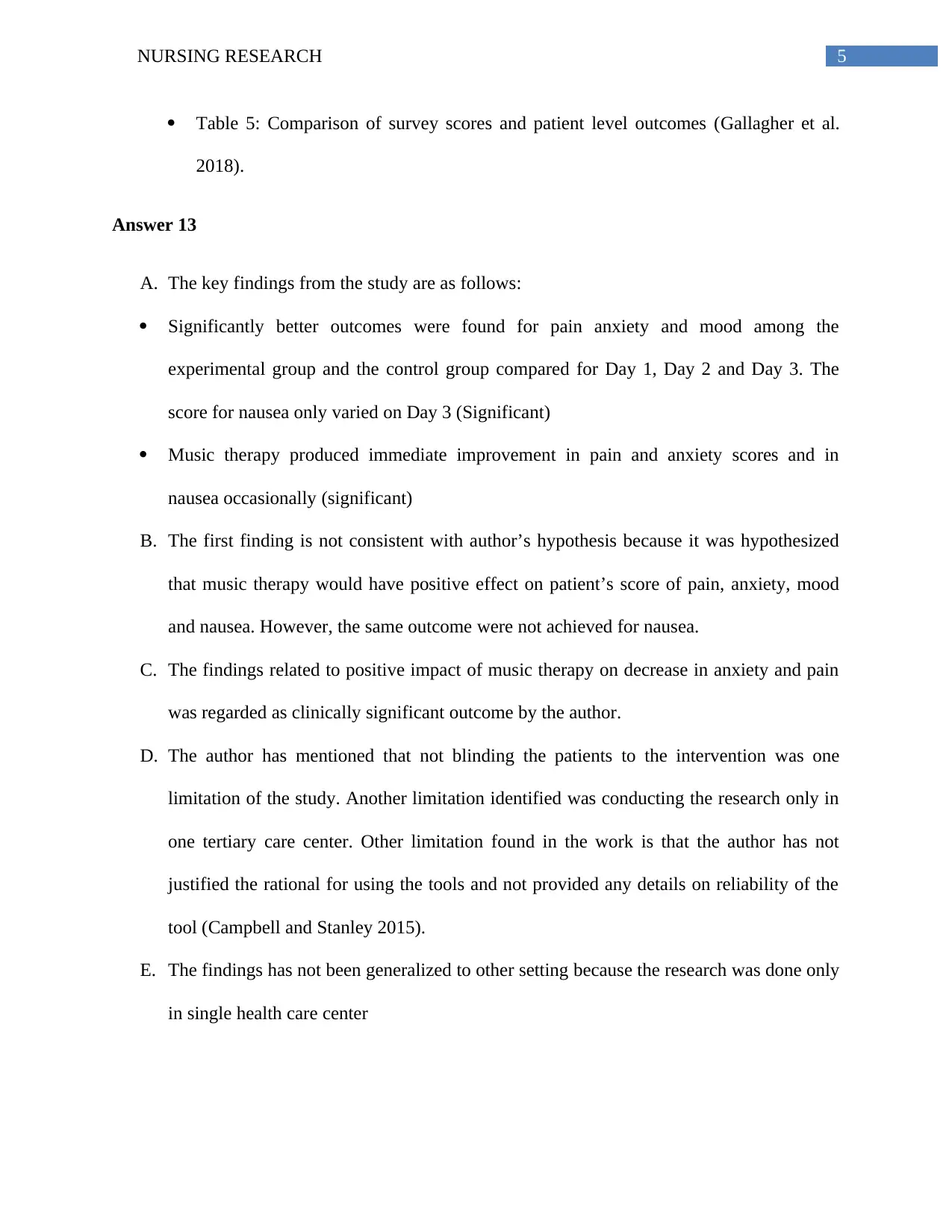
5NURSING RESEARCH
Table 5: Comparison of survey scores and patient level outcomes (Gallagher et al.
2018).
Answer 13
A. The key findings from the study are as follows:
Significantly better outcomes were found for pain anxiety and mood among the
experimental group and the control group compared for Day 1, Day 2 and Day 3. The
score for nausea only varied on Day 3 (Significant)
Music therapy produced immediate improvement in pain and anxiety scores and in
nausea occasionally (significant)
B. The first finding is not consistent with author’s hypothesis because it was hypothesized
that music therapy would have positive effect on patient’s score of pain, anxiety, mood
and nausea. However, the same outcome were not achieved for nausea.
C. The findings related to positive impact of music therapy on decrease in anxiety and pain
was regarded as clinically significant outcome by the author.
D. The author has mentioned that not blinding the patients to the intervention was one
limitation of the study. Another limitation identified was conducting the research only in
one tertiary care center. Other limitation found in the work is that the author has not
justified the rational for using the tools and not provided any details on reliability of the
tool (Campbell and Stanley 2015).
E. The findings has not been generalized to other setting because the research was done only
in single health care center
Table 5: Comparison of survey scores and patient level outcomes (Gallagher et al.
2018).
Answer 13
A. The key findings from the study are as follows:
Significantly better outcomes were found for pain anxiety and mood among the
experimental group and the control group compared for Day 1, Day 2 and Day 3. The
score for nausea only varied on Day 3 (Significant)
Music therapy produced immediate improvement in pain and anxiety scores and in
nausea occasionally (significant)
B. The first finding is not consistent with author’s hypothesis because it was hypothesized
that music therapy would have positive effect on patient’s score of pain, anxiety, mood
and nausea. However, the same outcome were not achieved for nausea.
C. The findings related to positive impact of music therapy on decrease in anxiety and pain
was regarded as clinically significant outcome by the author.
D. The author has mentioned that not blinding the patients to the intervention was one
limitation of the study. Another limitation identified was conducting the research only in
one tertiary care center. Other limitation found in the work is that the author has not
justified the rational for using the tools and not provided any details on reliability of the
tool (Campbell and Stanley 2015).
E. The findings has not been generalized to other setting because the research was done only
in single health care center
⊘ This is a preview!⊘
Do you want full access?
Subscribe today to unlock all pages.

Trusted by 1+ million students worldwide
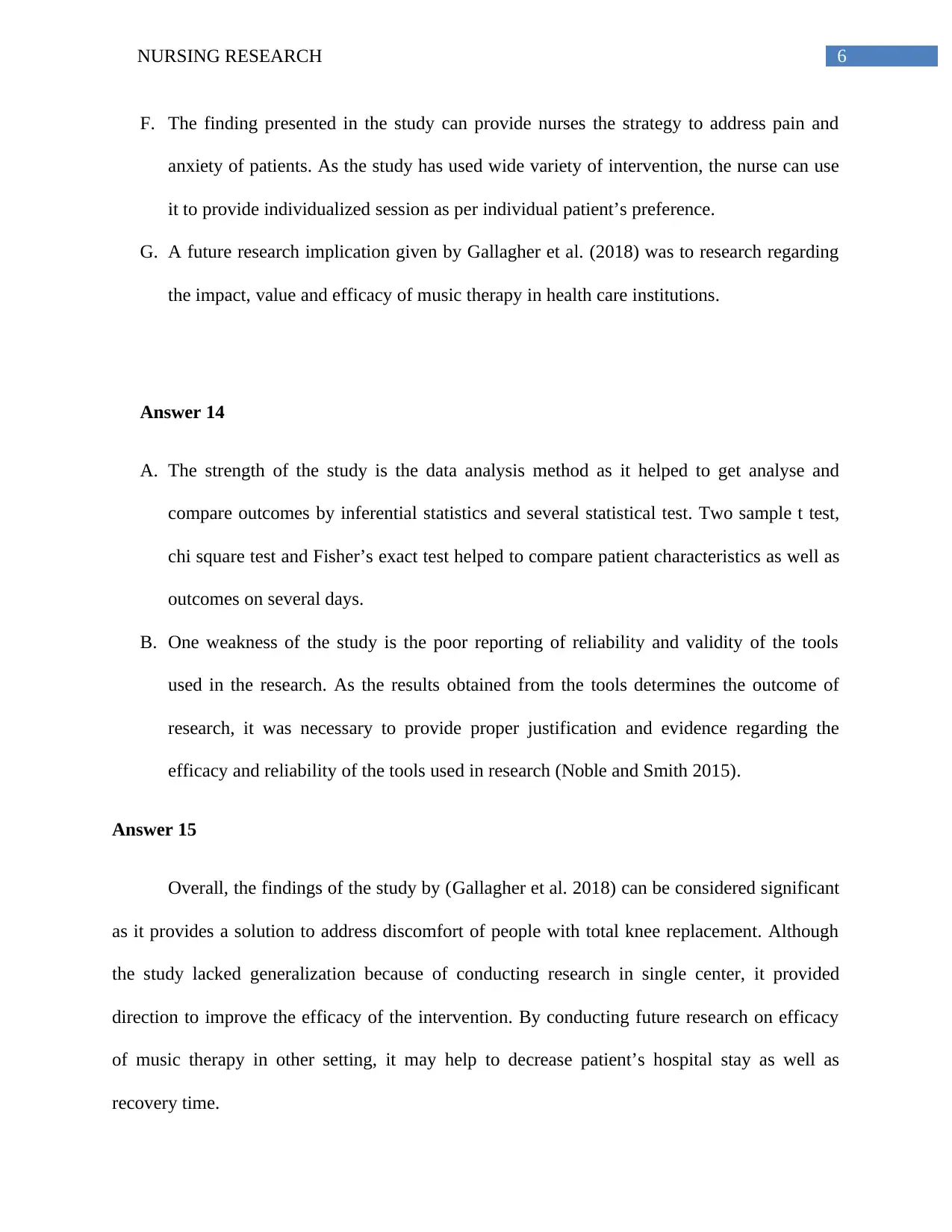
6NURSING RESEARCH
F. The finding presented in the study can provide nurses the strategy to address pain and
anxiety of patients. As the study has used wide variety of intervention, the nurse can use
it to provide individualized session as per individual patient’s preference.
G. A future research implication given by Gallagher et al. (2018) was to research regarding
the impact, value and efficacy of music therapy in health care institutions.
Answer 14
A. The strength of the study is the data analysis method as it helped to get analyse and
compare outcomes by inferential statistics and several statistical test. Two sample t test,
chi square test and Fisher’s exact test helped to compare patient characteristics as well as
outcomes on several days.
B. One weakness of the study is the poor reporting of reliability and validity of the tools
used in the research. As the results obtained from the tools determines the outcome of
research, it was necessary to provide proper justification and evidence regarding the
efficacy and reliability of the tools used in research (Noble and Smith 2015).
Answer 15
Overall, the findings of the study by (Gallagher et al. 2018) can be considered significant
as it provides a solution to address discomfort of people with total knee replacement. Although
the study lacked generalization because of conducting research in single center, it provided
direction to improve the efficacy of the intervention. By conducting future research on efficacy
of music therapy in other setting, it may help to decrease patient’s hospital stay as well as
recovery time.
F. The finding presented in the study can provide nurses the strategy to address pain and
anxiety of patients. As the study has used wide variety of intervention, the nurse can use
it to provide individualized session as per individual patient’s preference.
G. A future research implication given by Gallagher et al. (2018) was to research regarding
the impact, value and efficacy of music therapy in health care institutions.
Answer 14
A. The strength of the study is the data analysis method as it helped to get analyse and
compare outcomes by inferential statistics and several statistical test. Two sample t test,
chi square test and Fisher’s exact test helped to compare patient characteristics as well as
outcomes on several days.
B. One weakness of the study is the poor reporting of reliability and validity of the tools
used in the research. As the results obtained from the tools determines the outcome of
research, it was necessary to provide proper justification and evidence regarding the
efficacy and reliability of the tools used in research (Noble and Smith 2015).
Answer 15
Overall, the findings of the study by (Gallagher et al. 2018) can be considered significant
as it provides a solution to address discomfort of people with total knee replacement. Although
the study lacked generalization because of conducting research in single center, it provided
direction to improve the efficacy of the intervention. By conducting future research on efficacy
of music therapy in other setting, it may help to decrease patient’s hospital stay as well as
recovery time.
Paraphrase This Document
Need a fresh take? Get an instant paraphrase of this document with our AI Paraphraser
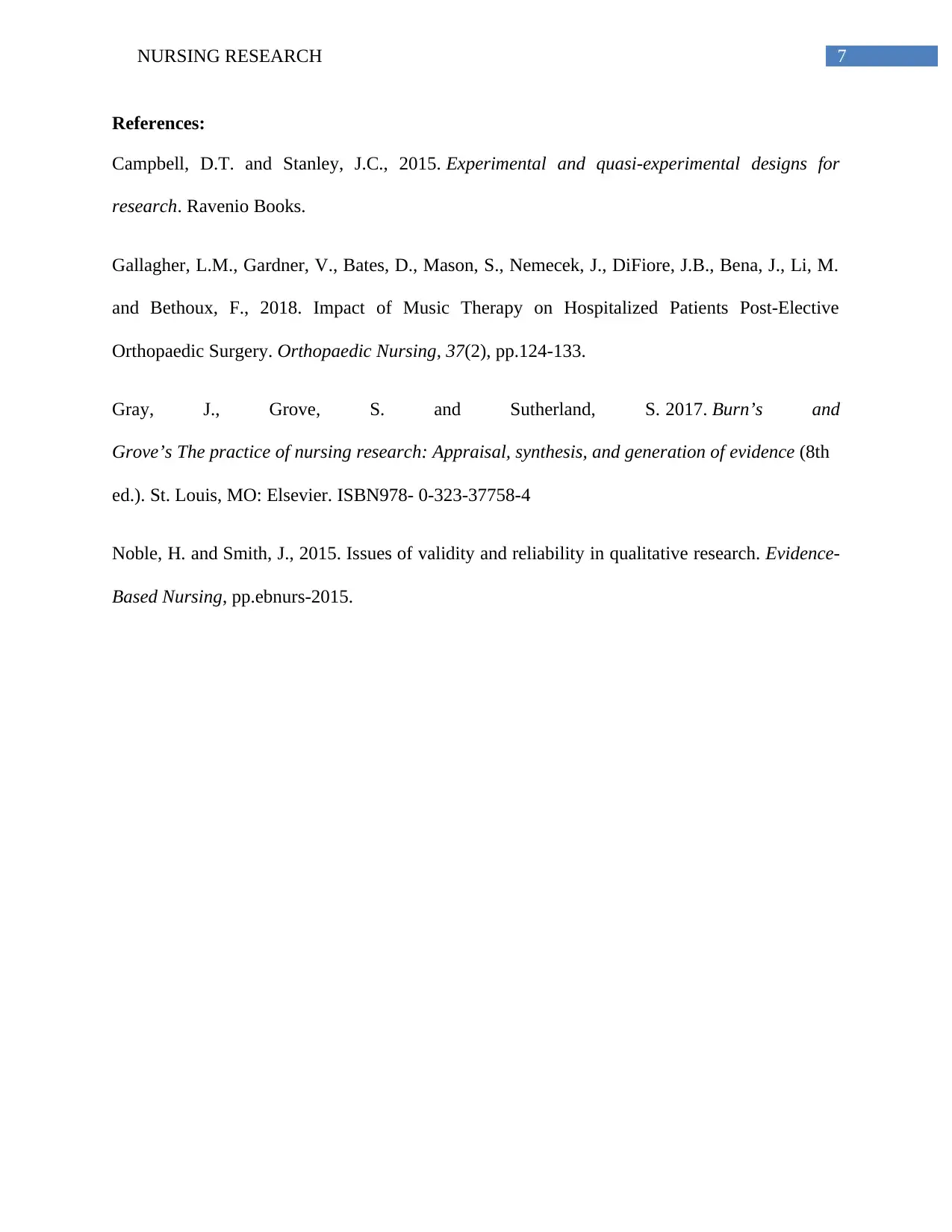
7NURSING RESEARCH
References:
Campbell, D.T. and Stanley, J.C., 2015. Experimental and quasi-experimental designs for
research. Ravenio Books.
Gallagher, L.M., Gardner, V., Bates, D., Mason, S., Nemecek, J., DiFiore, J.B., Bena, J., Li, M.
and Bethoux, F., 2018. Impact of Music Therapy on Hospitalized Patients Post-Elective
Orthopaedic Surgery. Orthopaedic Nursing, 37(2), pp.124-133.
Gray, J., Grove, S. and Sutherland, S. 2017. Burn’s and
Grove’s The practice of nursing research: Appraisal, synthesis, and generation of evidence (8th
ed.). St. Louis, MO: Elsevier. ISBN978- 0-323-37758-4
Noble, H. and Smith, J., 2015. Issues of validity and reliability in qualitative research. Evidence-
Based Nursing, pp.ebnurs-2015.
References:
Campbell, D.T. and Stanley, J.C., 2015. Experimental and quasi-experimental designs for
research. Ravenio Books.
Gallagher, L.M., Gardner, V., Bates, D., Mason, S., Nemecek, J., DiFiore, J.B., Bena, J., Li, M.
and Bethoux, F., 2018. Impact of Music Therapy on Hospitalized Patients Post-Elective
Orthopaedic Surgery. Orthopaedic Nursing, 37(2), pp.124-133.
Gray, J., Grove, S. and Sutherland, S. 2017. Burn’s and
Grove’s The practice of nursing research: Appraisal, synthesis, and generation of evidence (8th
ed.). St. Louis, MO: Elsevier. ISBN978- 0-323-37758-4
Noble, H. and Smith, J., 2015. Issues of validity and reliability in qualitative research. Evidence-
Based Nursing, pp.ebnurs-2015.

8NURSING RESEARCH
⊘ This is a preview!⊘
Do you want full access?
Subscribe today to unlock all pages.

Trusted by 1+ million students worldwide
1 out of 9
Your All-in-One AI-Powered Toolkit for Academic Success.
+13062052269
info@desklib.com
Available 24*7 on WhatsApp / Email
![[object Object]](/_next/static/media/star-bottom.7253800d.svg)
Unlock your academic potential
Copyright © 2020–2025 A2Z Services. All Rights Reserved. Developed and managed by ZUCOL.

